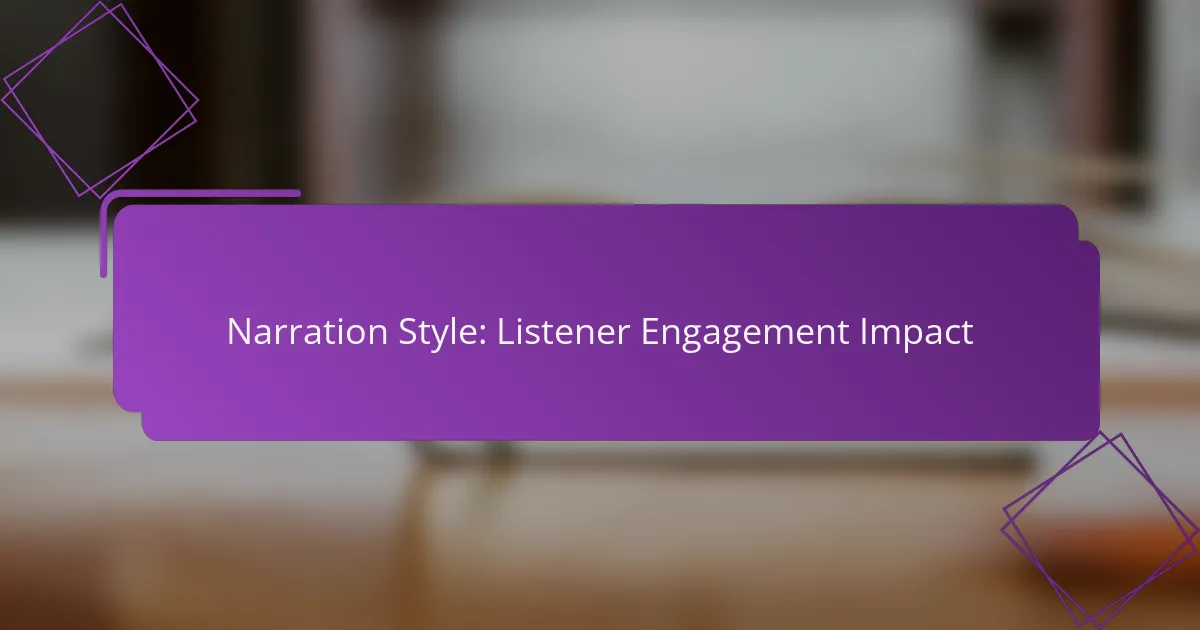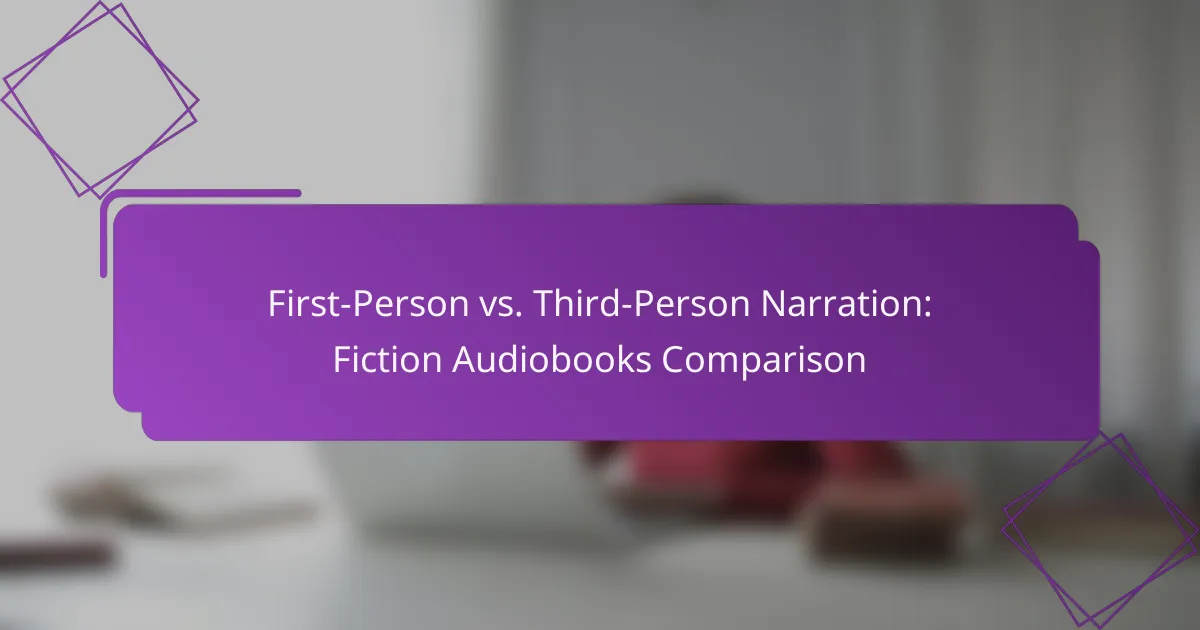Narration style plays a crucial role in listener engagement, influencing how audiences connect with the content. By employing techniques such as vocal variety and pacing, narrators can create a more immersive experience that not only captivates listeners but also enhances their understanding and retention of information.

How does narration style affect listener engagement?
Narration style significantly impacts listener engagement by shaping how the audience connects with the content. A compelling narration can evoke emotions, enhance understanding, and improve memory retention, making the experience more immersive and effective.
Emotional connection through storytelling
Storytelling is a powerful tool for creating emotional connections. When narrators use vivid imagery and relatable characters, listeners are more likely to feel invested in the narrative. For instance, a personal anecdote can resonate with the audience, making the content more memorable.
To foster this emotional bond, narrators should consider their tone, pacing, and the use of pauses. A well-timed pause can heighten anticipation, while a warm tone can create a sense of intimacy. Engaging stories often lead to a deeper emotional response, enhancing overall engagement.
Clarity and comprehension enhancement
A clear narration style enhances comprehension by making complex ideas accessible. Using straightforward language and structured delivery helps listeners follow along without confusion. For example, breaking down information into digestible segments can aid understanding.
Effective narrators often employ techniques such as repetition and summarization to reinforce key points. Additionally, varying vocal tone and pace can help emphasize important information, ensuring that listeners grasp the main ideas without feeling overwhelmed.
Influence on retention and recall
The style of narration plays a crucial role in how well listeners retain and recall information. Engaging narratives that incorporate storytelling elements tend to be remembered better than dry, factual presentations. Techniques like using analogies or relatable examples can significantly improve recall.
To maximize retention, narrators should aim to create a narrative arc that includes a clear beginning, middle, and end. This structure not only aids in understanding but also makes it easier for listeners to remember the content long after the narration has ended.

What are effective narration styles for e-commerce?
Effective narration styles for e-commerce engage customers and enhance their shopping experience. By utilizing various techniques, brands can create a compelling narrative that resonates with their audience and drives conversions.
Conversational narration
Conversational narration mimics a friendly dialogue, making the customer feel at ease and connected. This style often uses informal language, questions, and direct address to engage the listener. For example, phrases like “Have you ever wondered…” or “Imagine this…” invite customers to envision themselves using the product.
To implement conversational narration, consider using a tone that reflects your brand’s personality. Avoid jargon and keep sentences short and relatable. This approach can foster trust and encourage customers to explore your offerings further.
Descriptive narration
Descriptive narration focuses on painting a vivid picture of the product or service, highlighting its features and benefits. This style uses sensory details to help customers visualize the experience, such as “This soft, breathable fabric keeps you cool on hot summer days.” Such descriptions can evoke emotions and create a desire to purchase.
When employing descriptive narration, be specific and use adjectives that resonate with your target audience. Incorporate storytelling elements to make the product come alive, enhancing the overall appeal and encouraging customers to imagine how it fits into their lives.
Persuasive narration
Persuasive narration aims to convince the customer to take action, often by emphasizing urgency or exclusivity. This style may include phrases like “Limited time offer” or “Join thousands of satisfied customers.” It focuses on the benefits of the product and addresses potential objections.
To effectively use persuasive narration, highlight key selling points and include testimonials or social proof. Create a sense of urgency by incorporating time-sensitive promotions or limited stock notifications. This strategy can significantly boost conversion rates by motivating customers to make a purchase decision quickly.

Which narration techniques improve engagement?
Engagement in narration can be significantly enhanced through various techniques that capture and maintain the listener’s attention. Key methods include vocal variety, pacing strategies, and the effective use of pauses, each contributing to a more dynamic and compelling storytelling experience.
Vocal variety and modulation
Vocal variety involves changing pitch, tone, and volume to create a more engaging narrative. Modulation can help convey emotions, differentiate characters, and maintain listener interest. For example, a higher pitch may indicate excitement, while a lower tone can suggest seriousness.
To effectively use vocal variety, practice varying your voice during rehearsals. Aim for a balance; too much variation can be distracting, while too little may lead to monotony. A good rule of thumb is to incorporate changes every few sentences to keep the audience engaged.
Pacing and timing strategies
Pacing refers to the speed at which a story is told, while timing involves the strategic placement of words and phrases. Effective pacing can build suspense or allow the audience to absorb key points. For instance, slowing down during critical moments can enhance emotional impact.
Consider using a mix of fast and slow pacing to create rhythm in your narration. A practical approach is to speed up during action scenes and slow down during reflective moments. This variation helps maintain listener interest and emphasizes important content.
Use of pauses for emphasis
Pauses can be powerful tools in narration, allowing listeners to process information and heightening the impact of key statements. A well-timed pause can create anticipation or underscore a significant point. For example, pausing right before a critical reveal can amplify its effect.
To effectively incorporate pauses, practice identifying natural breaks in your narrative. Aim for pauses of one to three seconds, depending on the context. Avoid overusing pauses, as they can disrupt the flow; instead, use them strategically to enhance engagement.

How can brands measure listener engagement?
Brands can measure listener engagement through various methods that provide insights into how audiences interact with audio content. Key approaches include utilizing analytics tools, gathering feedback directly from listeners, and tracking specific engagement metrics and KPIs.
Analytics tools for audio content
Analytics tools are essential for brands to track listener behavior and engagement levels. These tools can provide data on play counts, average listening duration, and listener drop-off points, helping brands understand what resonates with their audience.
Popular analytics platforms include Google Analytics for web-based audio, Podtrac for podcast metrics, and Spotify for Artists, which offers insights specific to music streaming. Brands should choose tools that align with their content type and audience demographics.
Feedback and surveys from listeners
Direct feedback from listeners can offer invaluable insights into their preferences and experiences. Conducting surveys or polls can help brands gather qualitative data that analytics tools may not capture.
Brands can use platforms like SurveyMonkey or Typeform to create engaging surveys that ask specific questions about content quality, topics of interest, and overall satisfaction. Offering incentives for participation, such as discounts or exclusive content, can increase response rates.
Engagement metrics and KPIs
Engagement metrics and KPIs are critical for assessing the effectiveness of audio content. Common metrics include listener retention rates, social media shares, and listener growth over time.
Brands should establish clear KPIs based on their goals, such as increasing listener retention by a certain percentage or achieving a specific number of shares per episode. Regularly reviewing these metrics allows brands to adjust their strategies and improve listener engagement continuously.

What are the prerequisites for effective narration?
Effective narration requires a clear understanding of the target audience and alignment with the brand’s voice. These prerequisites ensure that the narrative resonates with listeners and maintains consistency with the overall messaging strategy.
Understanding target audience preferences
To engage listeners, it’s crucial to know their preferences, interests, and demographics. Conducting surveys or analyzing feedback can provide insights into what styles and topics resonate most with your audience.
Consider factors such as age, cultural background, and listening habits. For instance, younger audiences may prefer a more casual tone, while professionals might appreciate a formal approach. Tailoring your narration style to these preferences can significantly enhance listener engagement.
Content alignment with brand voice
Maintaining consistency with your brand’s voice is essential for effective narration. This means using language, tone, and style that reflect your brand’s identity and values. A mismatch can confuse listeners and dilute your message.
For example, a tech company might adopt a knowledgeable and innovative tone, while a lifestyle brand may choose a friendly and relatable style. Regularly revisiting your brand guidelines can help ensure that your narration remains aligned with your overall branding strategy.

How does cultural context influence narration style?
Cultural context significantly shapes narration style by determining how stories are told and received. It affects the choice of language, themes, and storytelling techniques, which can vary widely across different cultures.
Regional storytelling traditions
Regional storytelling traditions play a crucial role in shaping narration styles. For example, oral traditions in Indigenous cultures often emphasize community and shared experiences, while Western narratives may focus on individualism and character development. Understanding these traditions helps narrators connect with their audience more effectively.
In regions with rich folklore, such as the Balkans, stories may incorporate local myths and legends, enhancing the cultural resonance. Narrators should consider these elements to create authentic and engaging narratives that reflect their audience’s values and experiences.
Language and dialect considerations
Language and dialect are vital in tailoring narration styles to specific audiences. Using local dialects can enhance relatability and engagement, making the story feel more personal. For instance, a narrator in the UK might use regional slang to connect with listeners from that area, while a narrator in the US might adopt a different approach based on regional variations.
It’s essential to be mindful of language nuances, as certain phrases or expressions may hold different meanings across cultures. Avoiding overly complex language can also help ensure that the narrative is accessible to a broader audience. Narrators should strive for clarity while respecting the linguistic diversity of their listeners.

What are emerging trends in narration for e-commerce?
Emerging trends in narration for e-commerce focus on enhancing customer engagement through personalized and interactive storytelling. These trends leverage technology to create immersive shopping experiences that resonate with consumers.
Integration of AI-driven narration
AI-driven narration is transforming how e-commerce brands communicate with their customers. By utilizing machine learning algorithms, businesses can create tailored audio and visual content that adapts to individual user preferences and behaviors.
This technology allows for dynamic storytelling, where the narrative can change based on customer interactions, leading to a more engaging experience. For instance, an online clothing retailer might use AI to narrate product descriptions that highlight features relevant to a shopper’s past purchases.
When implementing AI-driven narration, consider the balance between automation and human touch. While AI can efficiently generate content, ensuring that it aligns with brand voice and customer expectations is crucial. Avoid overly robotic tones; instead, aim for a conversational style that feels personal and relatable.



